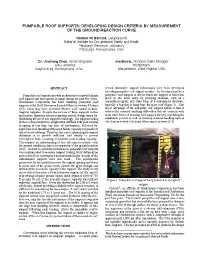Mining Publication: Pumpable Roof Supports: Developing Design Criteria by Measurement of the Ground Reaction Curve
Original creation date: August 2003
Pumpable roof supports provide an alternative longwall tailgate roof support and have grown in usage during the past few years. Heintzmann Corp. has been installing pumpable roof supports at the RAG Resources Emerald Mine in western Pennsylvania since 1998, where they have provided effective roof control in their longwall tailgates. Despite the success of these supports in this application, questions remain regarding critical design issues for optimizing the use of this support technology. The support loading profile is characterized by a high initial stiffness with peak loading occurring at less than 1 in of convergence, followed by significant load shedding with a postfailure capacity comparable to that of wood cribbing. Hence, the key to optimizing the support utilization is to provide sufficient load density to prevent convergence from occurring beyond the peak loading capacity. This requires an understanding of how the supports interact with the ground conditions, hence measurement of the ground reaction curve. In order to obtain this information, pumpable roof supports were instrumented to measure support loading. Roof deformation and roof-to-floor convergence measurements in the vicinity of the instrumented supports were also made. The experimental parameters for the installation were the support spacing and water-to-solids ratio of the grout, which controls the grout strength and ultimately the maximum capacity of the support. The study clearly shows that at this mine a 24-in-diam support is fully capable of providing adequate ground control under depths of cover of 750 ft as only 50% of the available support capacity was utilized outby the longwall face. It was also shown that the 2.00-to-1 water-solids ratio, despite providing a slightly softer support response, is sufficient for maintaining the same degree of roof control provided by the traditional 1.75-to-1 grout mix. The 10-ft spacing of the supports did not cause any ground control problems outby the face. However, inby the face the performance of the support is degraded once the peak capacity of the supports is exceeded. It appears that the large load shedding behavior, which is characteristic of this support following peak loading, allows the immediate roof to separate. When this happens, the support is unable to regain control of the roof in time to prevent failure of the immediate roof beam.
Authors: TM Barczak, J Chen, J Bower
Conference Paper - August 2003
NIOSHTIC2 Number: 20023427
Proceedings of the 22nd International Conference on Ground Control in Mining, Peng SS, Mark C, Khair AW, Heasley KA, eds. Morgantown, WV: West Virginia University, 2003 Aug; :283-294
See Also
- Analysis of the Interaction Between Mobile Roof Supports and Mine Strata
- Design Methodology for Standing Secondary Roof Support in Longwall Tailgates
- Evaluation of Support and Ground Response as Longwall Face Advances into and Widens Pre-Driven Recovery Room
- Evaluation of the Impact of Standing Support on Ground Behavior in Longwall Tailgates
- A First Step in Developing Roof Support Design Criteria Based on Ground Reaction Data for Pittsburgh Seam Longwall Tailgate Support
- Longwall Shield and Standing Gateroad Support Designs - Is Bigger Better?
- Longwall Tailgates: The Technology for Roof Support Has Improved, but Optimization is Still Not There
- Standing Support Alternatives in Western Longwalls
- Standing Support Alternatives in Western United States Longwalls
- Updating the NIOSH Support Technology Optimization Program (STOP) With New Support Technologies and Additional Design Features
- Page last reviewed: 9/21/2012
- Page last updated: 9/21/2012
- Content source: National Institute for Occupational Safety and Health, Mining Program


 ShareCompartir
ShareCompartir
